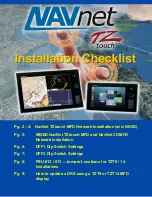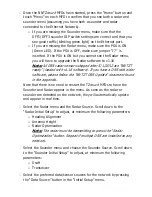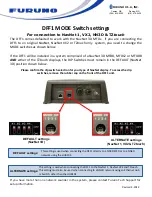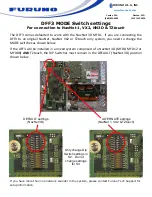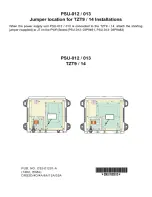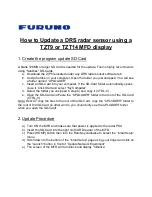
NavNet TZ
touch
Installation Checklist
NNTZ
touch
MFD Network Installation (without NN3D):
Connect all NNTZ
touch
MFDs to the Ethernet Network. If a HUB101 is
used, set the internal HUB DIP switches to OFF (HUB101 DIP Switches
are OFF by Default). NNTZ
touch
MFDs do not use “power-on”
synchronization.
Note: If you use the internal HUB of the NNTZT14, realize that the
HUB will only be able to relay Ethernet traffic when the MFD is turned
ON. For multi-station network installations, we recommend using an
external HUB (such as the Furuno HUB101) allowing redundancy in
case an MFD is powered OFF.
Connect all NNTZ
touch
MFDs to a proper NMEA2000 backbone using
drop cables (18 feet or less).
Note: NNTZtouch MFDs are fully NMEA2000 Certified and do not have
an internal terminal resistor that can be switched ON or OFF. All
connections to the NMEA2000 backbone must be “drop” connections
(18 feet or less).
Make sure the DFF1 and DFF3 are set up for “fixed IP addresses” (See
appendix for more information on setting up both)
Connect the Radar Ethernet and Power cable to the PSU, then connect
the second Ethernet port of the PSU to the HUB or directly to the
TZ
touch
MFD. Make sure that a jumper is inserted inside the PSU on
“J7”. (This allows the PSU to start without a power synchronization
signal).
Note: A sticker
“
Optional jumper for TZtouch included” is placed on all
PSU units that include a jumper for “J7” in the packaging! You MUST
still open the PSU and insert it. If you are utilizing an existing PSU, just
order the jumper (part # 001-183-760-00) and insert it on J7 to make
the PSU compatible with a NNTZtouch network.
Power ON the HUB, the PSU, the NMEA2000 backbone and all the
sensors, then start the NNTZ
touch
MFDs.
Note: During the power ON sequence, the NNTZtouch MFDs display a
black screen for 10-15 seconds: this is normal.
Содержание TZtouch
Страница 8: ......

